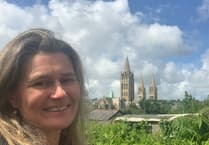WE were down in the valley on the outskirts of the village, where the young Camel river rushes its way south. We were cutting thistles in a six acre field belonging to Ant Snooze, Rog the Oil’s nephew, and he wanted to get sheep back in there.
It was a beautiful day, a bit hot if truth be told to spend three hours bouncing on the seat of the The Little Grey Fergie (did the spring on the seat bottom out quite as often 50 years ago?). However, buzzards were mewing in the sky and the river looked inviting. So much so, Tim and Tim ventured in for a dip but I think the appeal of cold water has faded for me. Moreover, the little tractor was a star, successfully topping the field and leaving a shepherd very happy.
The Camel is about 30 miles long, rising north of Camelford and flowing in a southerly direction towards Bodmin, picking up the De Lank river on the way, before a sharp right turn sees it flowing in the Camel estuary, which is tidal up to Egloshayle. It is the second-longest river wholly in Cornwall. You won’t see many camels, though, mainly because the name derives from the Cornish name of Dowr Kammel, or “crooked river”, which is pretty accurate. The wildlife is incredibly diverse with a wide range of fish and insects calling it home, including otters these days.
Personally, I think the bridge over the Camel at Wadebridge is spectacular but you don’t appreciate it as you drive over. Built in 1460, it has 17 arches and must have been cutting edge technology when finished. Ships of up to 60 tonnes came up to Wadebridge, trading coal, slate, cider, sand and corn. It must have been a real metropolis and a bustling port - well worth a visit then and now.





Comments
This article has no comments yet. Be the first to leave a comment.